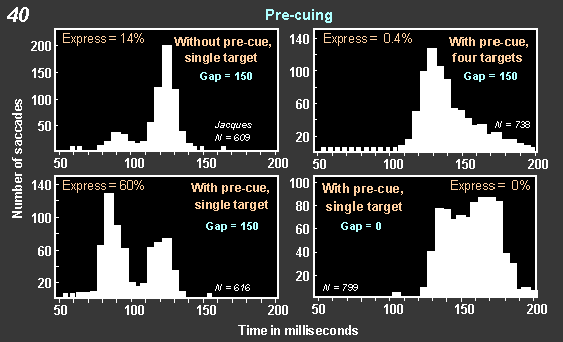The Neural
Control of Visually Guided Eye Movements
D. Temporal Factors in Visually Guided Saccadic Eye Movements
1. The conditions under which express
saccades can and cannot be generated.
j. Does pre-cuing target locations increase the
frequency with which express saccades are produced?
What has been described in Figures
33, 34 and
35 suggests that
the frequency with which express saccades are generated depends heavily
on some form of generalized expectation as to where targets might appear.
One way to test this idea further is to pre-cue the expected target location
on each trial. This was accomplished by briefly presenting a stimulus
just prior to the fixation spot at the location of the impending target.
This cue stimulus was identical in size, color and shape to the target.
The left two panels of Figure
40 show data from a monkey with and without pre-cuing using
four target locations and gap times of 150 milliseconds. The results show
a much higher percentage of express saccades under the pre-cued condition
than without pre-cuing. However, pre-cuing had only restricted effects
in increasing express saccade generation. This is documented with the
two panels on the right of Figure 40.
The top right panels shows that when four identical targets appear simultaneously,
one of which is pre-cued, there are few express saccades produced. The
information provided by the pre-cue was effectively utilized by the monkey
as established by the fact that thethe pre-cued target was correctly chosen
76-95% of the time. The bottom right panel shows that when single targets
appear with no gap, pre-duing does not generate any express saccades.

These findings suggest that pre-cuing can increase express saccade frequency but can do so only when single targets are presented with a gap. This supports the idea that some form of generalized expectation of target appearance at specific locations underlies express saccade generation. Expectation in itself, however, is not sufficient. Single target presentation and a gap are essential.
|
